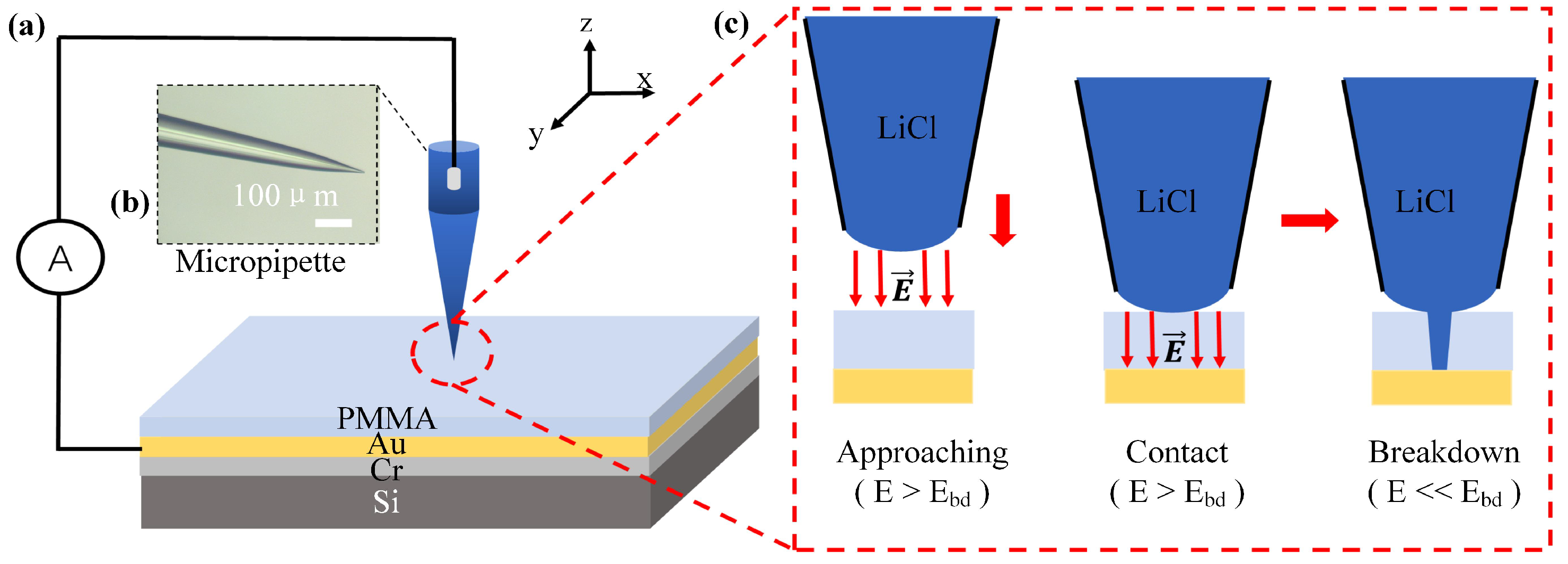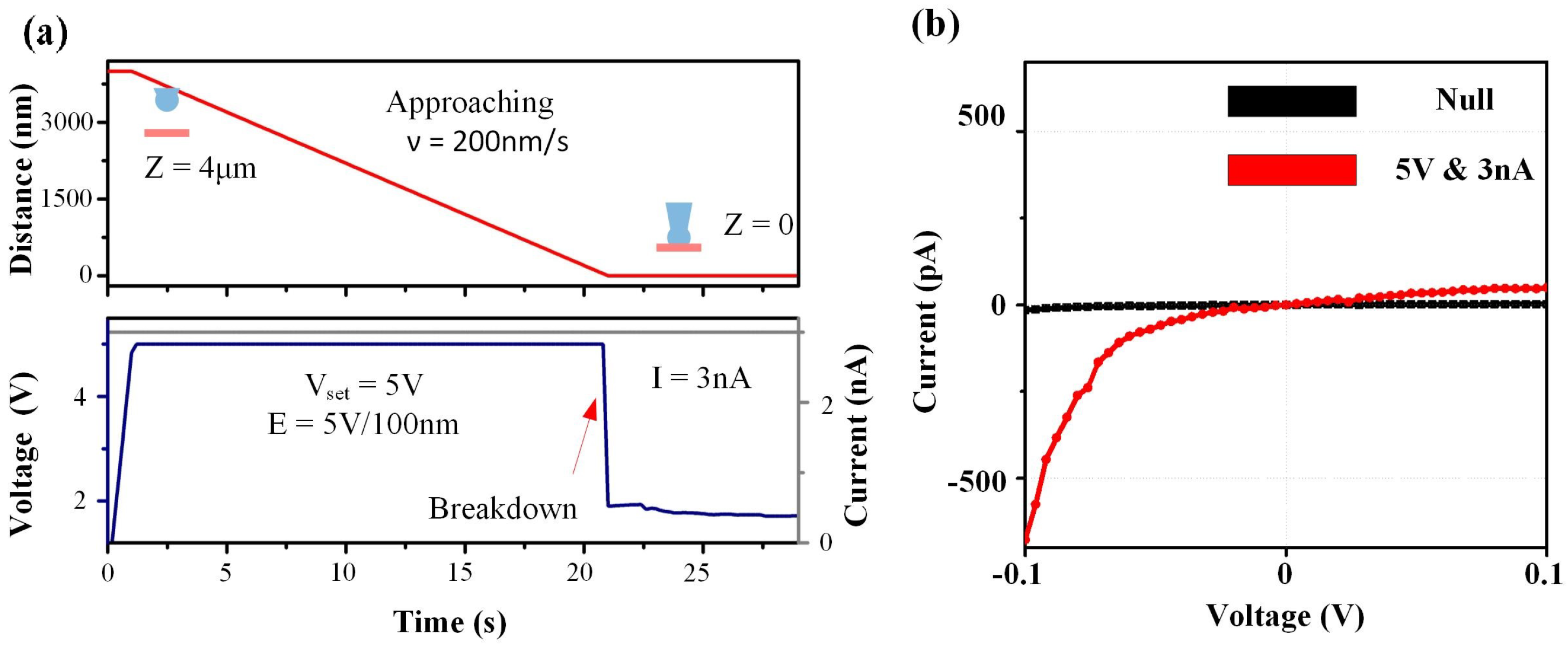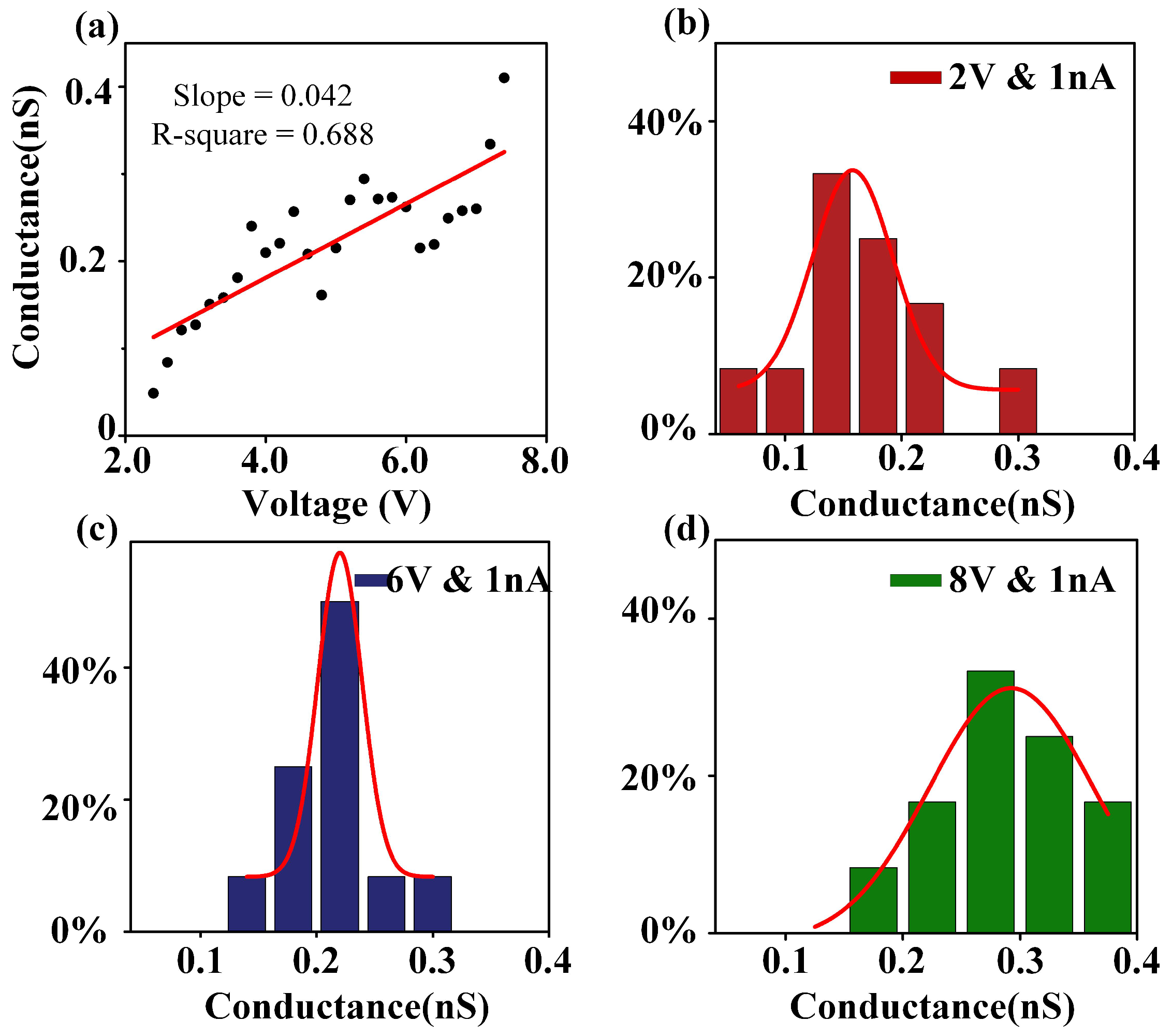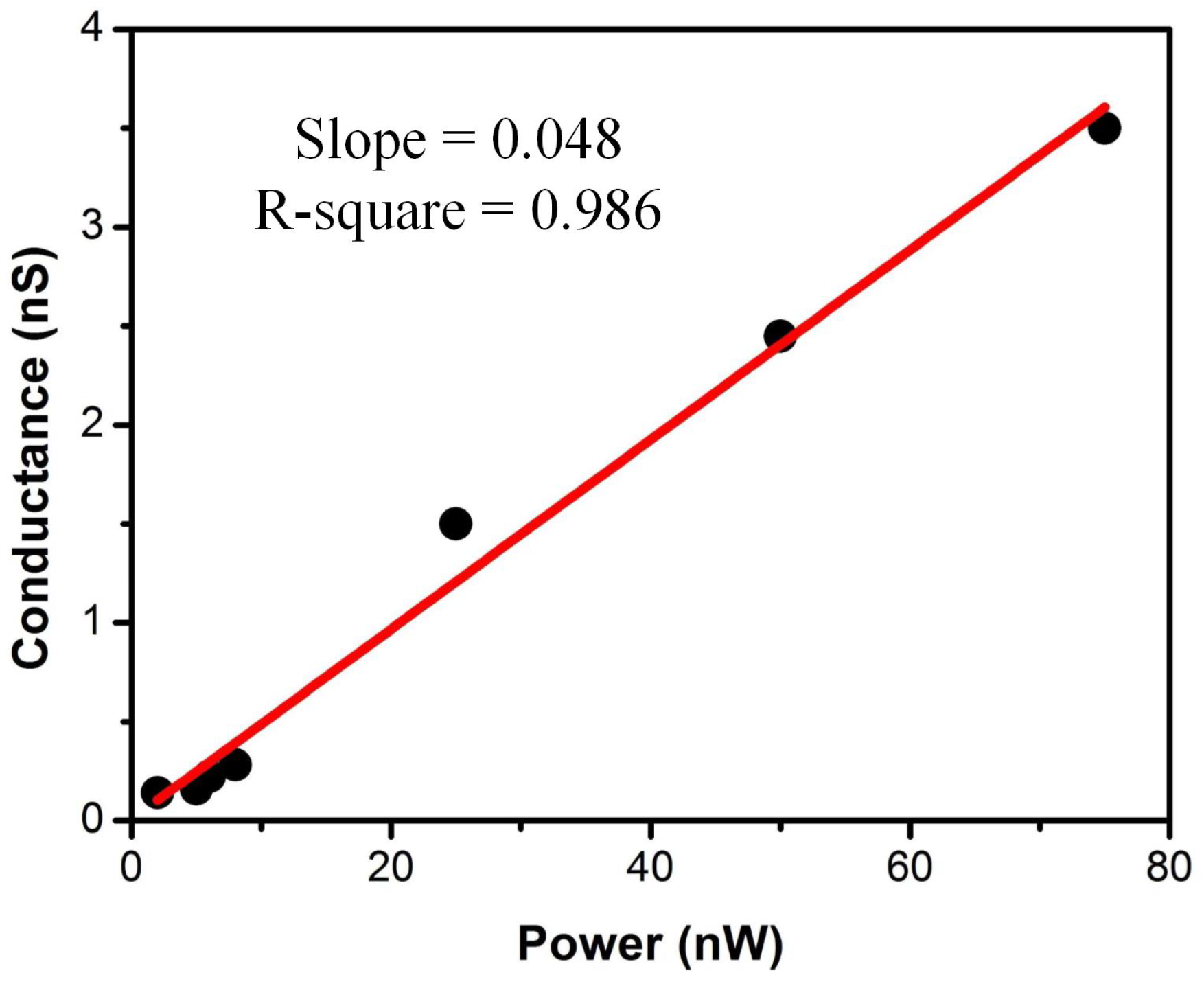Fast Fabrication Nanopores on a PMMA Membrane by a Local High Electric Field Controlled Breakdown
Abstract
1. Introduction
2. Materials and Methods
3. Results
3.1. Preparation of PMMA Membrane
3.2. Platform for PMMA Nanopore Fabrication
3.3. The Process of PMMA Nanopore Fabrication
3.4. Voltage Effect for PMMA Nanopore Fabrication
3.5. Current Effect for PMMA Nanopore Fabrication
3.6. Characterization of PMMA Nanopores
4. Discussion
5. Conclusions
Supplementary Materials
Author Contributions
Funding
Institutional Review Board Statement
Informed Consent Statement
Data Availability Statement
Conflicts of Interest
References
- Xue, L.; Yamazaki, H.; Ren, R.; Wanunu, M.; Ivanov, A.P.; Edel, J.B. Solid-state nanopore sensors. Nat. Rev. Mater. 2020, 5, 931–951. [Google Scholar] [CrossRef]
- Faramarzi, V.; Ahmadi, V.; Fotouhi, B.; Abasifard, M. A potential sensing mechanism for DNA nucleobases by optical properties of GO and MoS2 Nanopores. Sci. Rep. 2019, 9, 6230. [Google Scholar] [CrossRef]
- Feng, J.D.; Liu, K.; Bulushev, R.D.; Khlybov, S.; Dumcenco, D.; Kis, A.; Radenovic, A. Identification of single nucleotides in MoS2 nanopores. Nat. Nanotechnol. 2015, 10, 1070–1076. [Google Scholar] [CrossRef]
- Hyun, C.; Kaur, H.; Rollings, R.; Xiao, M.; Li, J.L. Threading Immobilized DNA Molecules through a Solid-State Nanopore at >100 μs per Base Rate. ACS Nano 2013, 7, 5892–5900. [Google Scholar] [CrossRef]
- Yuan, Z.S.; Liu, Y.M.; Dai, M.; Yi, X.; Wang, C.Y. Controlling DNA Translocation Through Solid-state Nanopores. Nanoscale Res. Lett. 2020, 15, 80. [Google Scholar] [CrossRef]
- Dong, Z.X.; Kennedy, E.; Hokmabadi, M.; Timp, G. Discriminating Residue Substitutions in a Single Protein Molecule Using a Sub-nanopore. ACS Nano 2017, 11, 5440–5452. [Google Scholar] [CrossRef]
- Sha, J.J.; Si, W.; Xu, B.; Zhang, S.; Li, K.; Lin, K.B.; Shi, H.J.; Chen, Y.F. Identification of Spherical and Nonspherical Proteins by a Solid-State Nanopore. Anal. Chem. 2018, 90, 13826–13831. [Google Scholar] [CrossRef]
- Akahori, R.; Yanagi, I.; Goto, Y.; Harada, K.; Yokoi, T.; Takeda, K. Discrimination of three types of homopolymers in single-stranded DNA with solid-state nanopores through external control of the DNA motion. Sci. Rep. 2017, 7, 9073. [Google Scholar] [CrossRef]
- Goto, Y.; Akahori, R.; Yanagi, I.; Takeda, K. Solid-state nanopores towards single-molecule DNA sequencing. J. Hum. Genet. 2020, 65, 69–77. [Google Scholar] [CrossRef]
- Schneider, G.F.; Kowalczyk, S.W.; Calado, V.E.; Pandraud, G.; Zandbergen, H.W.; Vandersypen, L.M.K.; Dekker, C. DNA Translocation through Graphene Nanopores. Nano Lett. 2010, 10, 3163–3167. [Google Scholar] [CrossRef]
- Briggs, K.; Kwok, H.; Tabard-Cossa, V. Automated Fabrication of 2-nm Solid-State Nanopores for Nucleic Acid Analysis. Small 2014, 10, 2077–2086. [Google Scholar] [CrossRef]
- Waduge, P.; Bilgin, I.; Larkin, J.; Henley, R.Y.; Goodfellow, K.; Graham, A.C.; Bell, D.C.; Vamivakas, N.; Kar, S.; Wanunu, M. Direct and Scalable Deposition of Atomically Thin Low-Noise MoS2 Membranes on Apertures. ACS Nano 2015, 9, 7352–7359. [Google Scholar] [CrossRef] [PubMed]
- Guo, B.Y.; Zeng, T.; Wu, H.C. Recent advances of DNA sequencing via nanopore-based technologies. Sci. Bull. 2015, 60, 287–295. [Google Scholar] [CrossRef]
- Matsui, K.; Goto, Y.; Yanagi, I.; Akahori, R.; Fujioka, M.; Ishida, T.; Yokoi, T.; Nakagawa, T.; Takeda, K. Low-frequency noise induced by cation exchange fluctuation on the wall of silicon nitride nanopore. Sci. Rep. 2020, 10, 8662. [Google Scholar] [CrossRef]
- Hartel, A.J.W.; Shekar, S.; Ong, P.; Schroeder, I.; Thiel, G.; Shepard, K.L. High bandwidth approaches in nanopore and ion channel recordings—A tutorial review. Anal. Chim. Acta 2019, 1061, 13–27. [Google Scholar] [CrossRef]
- Saharia, J.; Bandara, Y.M.N.D.Y.; Karawdeniya, B.I.; Alexandrakis, G.; Kim, M.J. Assessment of 1/f noise associated with nanopores fabricated through chemically tuned controlled dielectric breakdown. Electrophoresis 2021, 42, 899–909. [Google Scholar] [CrossRef]
- Uram, J.D.; Ke, K.; Mayer, M. Noise and bandwidth of current recordings from submicrometer pores and nanopores. ACS Nano 2008, 2, 857–872. [Google Scholar] [CrossRef]
- Beamish, E.; Kwok, H.; Tabard-Cossa, V.; Godin, M. Fine-tuning the Size and Minimizing the Noise of Solid-state Nanopores. Jove-J. Vis. Exp. 2013, 80, e51081. [Google Scholar]
- Xia, P.K.; Zuo, J.W.; Paudel, P.; Choi, S.; Chen, X.H.; Laskar, M.A.R.; Bai, J.; Song, W.S.; Im, J.; Wang, C. Sapphire-supported nanopores for low-noise DNA sensing. Biosens. Bioelectron. 2021, 174, 112829. [Google Scholar] [CrossRef]
- Balan, A.; Machielse, B.; Niedzwiecki, D.; Lin, J.; Ong, P.; Engelke, R.; Shepard, K.L.; Drndić, M. Improving Signal-to-Noise Performance for DNA Translocation in Solid-State Nanopores at MHz Bandwidths. Nano Lett. 2014, 14, 7215–7220. [Google Scholar] [CrossRef]
- Pitchford, W.H.; Kim, H.J.; Ivanov, A.P.; Kim, H.M.; Yu, J.S.; Leatherbarrow, R.J.; Albrecht, T.; Kim, K.B.; Edel, J.B. Synchronized Optical and Electronic Detection of Biomolecules Using a Low Noise Nanopore Platform. ACS Nano 2015, 9, 1740–1748. [Google Scholar] [CrossRef]
- Leong, I.W.; Tsutsui, M.; Nakada, T.; Taniguchi, M.; Washio, T.; Kawai, T. Back-Side Polymer-Coated Solid-State Nanopore Sensors. ACS Omega 2019, 4, 12561–12566. [Google Scholar] [CrossRef] [PubMed]
- Zhang, B.; Galusha, J.; Shiozawa, P.G.; Wang, G.L.; Bergren, A.J.; Jones, R.M.; White, R.J.; Ervin, E.N.; Cauley, C.C.; White, H.S. Bench-top method for fabricating glass-sealed nanodisk electrodes, glass nanopore electrodes, and glass nanopore membranes of controlled size. Anal. Chem. 2007, 79, 4778–4787. [Google Scholar] [CrossRef]
- Mara, A.; Siwy, Z.; Trautmann, C.; Wan, J.; Kamme, F. An asymmetric polymer nanopore for single molecule detection. Nano Lett. 2004, 4, 497–501. [Google Scholar] [CrossRef]
- Choi, J.; Lee, C.C.; Park, S. Scalable fabrication of sub-10 nm polymer nanopores for DNA analysis. Microsyst. Nanoeng. 2019, 5, 3–10. [Google Scholar] [CrossRef] [PubMed]
- MacKenzie, M.; Argyropoulos, C. An Introduction to Nanopore Sequencing: Past, Present, and Future Considerations. Micromachines 2023, 14, 459. [Google Scholar] [CrossRef] [PubMed]
- Salehirozveh, M.; Larsen, A.K.; Stojmenovic, M.; Thei, F.; Dong, M.D. In-situ PLL-g-PEG Functionalized Nanopore for Enhancing Protein Characterization. Chem.-Asian J. 2023, 18, e202300515. [Google Scholar] [CrossRef] [PubMed]
- Jia, Z.; Choi, J.; Lee, S.; Soper, S.A.; Park, S. Modifying surface charge density of thermoplastic nanofluidic biosensors by multivalent cations within the slip plane of the electric double layer. Colloids Surf. A-Physicochem. Eng. 2022, 648, 129147. [Google Scholar] [CrossRef] [PubMed]
- Yanagi, I.; Akahori, R.; Hatano, T.; Takeda, K. Fabricating nanopores with diameters of sub-1 nm to 3 nm using multilevel pulse-voltage injection. Sci. Rep. 2014, 4, 5000. [Google Scholar] [CrossRef] [PubMed]
- Kwok, H.; Briggs, K.; Tabard-Cossa, V. Nanopore Fabrication by Controlled Dielectric Breakdown. PLoS ONE 2014, 9, e92880. [Google Scholar] [CrossRef]
- Waugh, M.; Briggs, K.; Gunn, D.; Gibeault, M.; King, S.; Ingram, Q.; Jimenez, A.M.; Berryman, S.; Lomovtsev, D.; Andrzejewski, L.; et al. Solid-state nanopore fabrication by automated controlled breakdown. Nat. Protoc. 2020, 15, 122–143. [Google Scholar] [CrossRef] [PubMed]
- Fried, J.P.; Swett, J.L.; Nadappuram, B.P.; Mol, J.A.; Edel, J.B.; Ivanov, A.P.; Yates, J.R. In situ solid-state nanopore fabrication. Chem. Soc. Rev. 2021, 50, 4974–4992. [Google Scholar] [CrossRef] [PubMed]
- Roshan, K.A.; Tang, Z.F.; Guan, W.H. High fidelity moving Z-score based controlled breakdown fabrication of solid-state nanopore. Nanotechnology 2019, 30, 095502. [Google Scholar] [CrossRef] [PubMed]
- Fang, S.X.; Yin, B.H.; Xie, W.Y.; Zhou, D.M.; Tang, P.; He, S.X.; Yuan, J.H.; Wang, D.Q. A novel dielectric breakdown apparatus for solid-state nanopore fabrication with transient high electric field. Rev. Sci. Instrum. 2020, 91, 093203. [Google Scholar] [CrossRef] [PubMed]
- Yin, B.H.; Fang, S.X.; Zhou, D.M.; Liang, L.Y.; Wang, L.; Wang, Z.B.; Wang, D.Q.; Yuan, J.H. Nanopore Fabrication via Transient High Electric Field Controlled Breakdown and Detection of Single RNA Molecules. ACS Appl. Bio Mater. 2020, 3, 6368–6375. [Google Scholar] [CrossRef] [PubMed]
- Zhang, Y.N.; Miyahara, Y.; Derriche, N.; Yang, W.; Yazda, K.; Capaldi, X.; Liu, Z.Z.; Grutter, P.; Reisner, W. Nanopore Formation via Tip-Controlled Local Breakdown Using an Atomic Force Microscope. Small Methods 2019, 3, 1900147. [Google Scholar] [CrossRef]
- Arcadia, C.E.; Reyes, C.C.; Rosenstein, J.K. In Situ Nanopore Fabrication and Single-Molecule Sensing with Microscale Liquid Contacts. Acs Nano 2017, 11, 4907–4915. [Google Scholar] [CrossRef]
- Wasfi, A.; Awwad, F.; Ayesh, A.I. Graphene-based nanopore approaches for DNA sequencing: A literature review. Biosens. Bioelectron. 2018, 119, 191–203. [Google Scholar] [CrossRef] [PubMed]
- Chantiwas, R.; Park, S.; Soper, S.A.; Kim, B.C.; Takayama, S.; Sunkara, V.; Hwang, H.; Cho, Y.K. Flexible fabrication and applications of polymer nanochannels and nanoslits. Chem. Soc. Rev. 2011, 40, 3677–3702. [Google Scholar] [CrossRef]
- Zakrevskii, V.A.; Pakhotin, V.A.; Sudar, N.T. Dielectric Aging and Dielectric Degradation (Breakdown) of Polymer Films in AC Electric Fields. Phys. Solid State 2019, 61, 1915–1921. [Google Scholar] [CrossRef]
- Wang, Y.L.; Ying, C.F.; Zhou, W.Y.; de Vreede, L.; Liu, Z.B.; Tian, J.G. Fabrication of multiple nanopores in a SiNx membrane via controlled breakdown. Sci. Rep. 2018, 8, 1234. [Google Scholar] [CrossRef] [PubMed]
- Ying, C.F.; Zhang, Y.C.; Feng, Y.X.; Zhou, D.M.; Wang, D.Q.; Xiang, Y.X.; Zhou, W.Y.; Chen, Y.S.; Du, C.L.; Tian, J.G. 3D nanopore shape control by current-stimulus dielectric breakdown. Appl. Phys. Lett. 2016, 109, 063105. [Google Scholar] [CrossRef]
- Zhou, D.M.; Deng, Y.S.; Ying, C.F.; Zhang, Y.C.; Feng, Y.X.; Huang, Q.M.; Liang, L.Y.; Wang, D.Q. Rectification of Ion Current Determined by the Nanopore Geometry: Experiments and Modelling. Chin. Phys. Lett. 2016, 33, 108501. [Google Scholar] [CrossRef]
- Leung, C.; Briggs, K.; Laberge, M.P.; Peng, S.; Waugh, M.; Tabard-Cossa, V. Mechanisms of solid-state nanopore enlargement under electrical stress. Nanotechnology 2020, 31, 44LT01. [Google Scholar] [CrossRef]
- Actis, P.; Mak, A.C.; Pourmand, N. Functionalized nanopipettes: Toward label-free, single cell biosensors. Bioanal. Rev. 2010, 1, 177–185. [Google Scholar] [CrossRef] [PubMed]
- Kowalczyk, S.W.; Grosberg, A.Y.; Rabin, Y.; Dekker, C. Modeling the conductance and DNA blockade of solid-state nanopores. Nanotechnology 2011, 22, 315101. [Google Scholar] [CrossRef] [PubMed]
- Venkatesan, B.M.; Estrada, D.; Banerjee, S.; Jin, X.Z.; Dorgan, V.E.; Bae, M.H.; Aluru, N.R.; Pop, E.; Bashir, R. Stacked Graphene-Al2O3 Nanopore Sensors for Sensitive Detection of DNA and DNA-Protein Complexes. ACS Nano 2012, 6, 441–450. [Google Scholar] [CrossRef] [PubMed]
- Fried, J.P.; Swett, J.L.; Nadappuram, B.P.; Fedosyuk, A.; Sousa, P.M.; Briggs, D.P.; Ivanov, A.P.; Edel, J.B.; Mol, J.A.; Yates, J.R. Understanding Electrical Conduction and Nanopore Formation During Controlled Breakdown. Small 2021, 17, 2102543. [Google Scholar] [CrossRef] [PubMed]
- Habermehl, S.; Apodaca, R.T. Correlation of charge transport to intrinsic strain in silicon oxynitride and Si-rich silicon nitride thin films. Appl. Phys. Lett. 2004, 84, 215–217. [Google Scholar] [CrossRef]
- Chou, Y.-C.; Das, P.M.; Monos, D.S.; Drndic, M. Lifetime and Stability of Silicon Nitride Nanopores and Nanopore Arrays for Ionic Measurements. ACS Nano 2020, 14, 6715–6728. [Google Scholar] [CrossRef]






| No. | Fabrication Parameter | Resistance (MΩ) | rt (nm) | Bottom Diameter (2rb) (nm) |
|---|---|---|---|---|
| 1 | 5 V & 10 nA | 408 | 353/2 | 5.20 |
| 2 | 5 V & 5 nA | 667 | 148/2 | 3.60 |
| 3 | 8 V & 1 nA | 3558 | 0.60 | |
| 4 | 6 V & 1 nA | 4504 | 0.46 | |
| 5 | 5 V & 1 nA | 6250 | 0.36 | |
| 6 | 2 V & 1 nA | 7042 | 0.30 |
Disclaimer/Publisher’s Note: The statements, opinions and data contained in all publications are solely those of the individual author(s) and contributor(s) and not of MDPI and/or the editor(s). MDPI and/or the editor(s) disclaim responsibility for any injury to people or property resulting from any ideas, methods, instructions or products referred to in the content. |
© 2024 by the authors. Licensee MDPI, Basel, Switzerland. This article is an open access article distributed under the terms and conditions of the Creative Commons Attribution (CC BY) license (https://creativecommons.org/licenses/by/4.0/).
Share and Cite
Fang, S.; Zeng, D.; He, S.; Li, Y.; Pang, Z.; Wang, Y.; Liang, L.; Weng, T.; Xie, W.; Wang, D. Fast Fabrication Nanopores on a PMMA Membrane by a Local High Electric Field Controlled Breakdown. Sensors 2024, 24, 2109. https://doi.org/10.3390/s24072109
Fang S, Zeng D, He S, Li Y, Pang Z, Wang Y, Liang L, Weng T, Xie W, Wang D. Fast Fabrication Nanopores on a PMMA Membrane by a Local High Electric Field Controlled Breakdown. Sensors. 2024; 24(7):2109. https://doi.org/10.3390/s24072109
Chicago/Turabian StyleFang, Shaoxi, Delin Zeng, Shixuan He, Yadong Li, Zichen Pang, Yunjiao Wang, Liyuan Liang, Ting Weng, Wanyi Xie, and Deqiang Wang. 2024. "Fast Fabrication Nanopores on a PMMA Membrane by a Local High Electric Field Controlled Breakdown" Sensors 24, no. 7: 2109. https://doi.org/10.3390/s24072109
APA StyleFang, S., Zeng, D., He, S., Li, Y., Pang, Z., Wang, Y., Liang, L., Weng, T., Xie, W., & Wang, D. (2024). Fast Fabrication Nanopores on a PMMA Membrane by a Local High Electric Field Controlled Breakdown. Sensors, 24(7), 2109. https://doi.org/10.3390/s24072109






